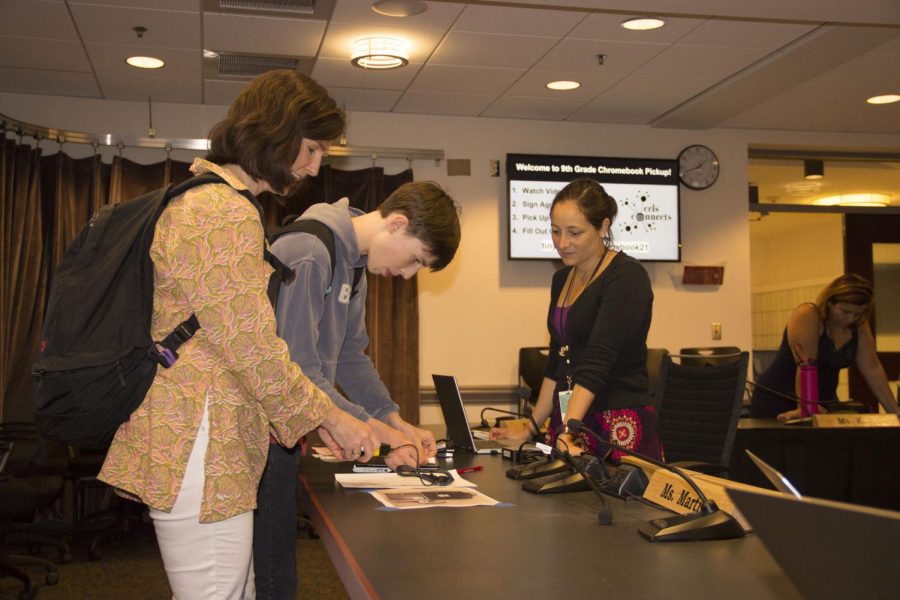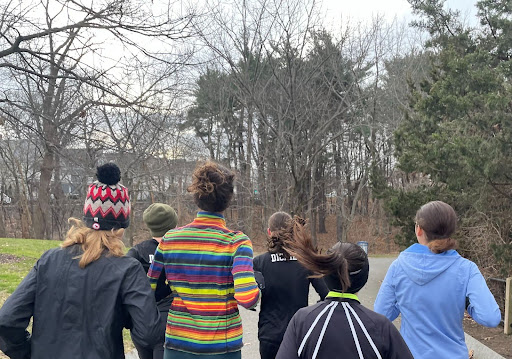One Student, One Laptop
Freshman students and their families picked up their Chromebooks during the first couple weeks of October.
October 30, 2017
Chromebooks boot up in seven seconds, do not need to be updated, and have a battery life that lasts throughout the school day. For these reasons, many schools, including CRLS, have promoted the use of these devices in recent years. Starting this fall, the Cambridge Public School District has taken a another step, kick-starting an initiative that provides all 498 students in the freshman class at CRLS—since no students opted out—with free Chromebooks to use at school and at home throughout their high school career, and even after they graduate.
“Our goal is for all students to have 24/7 access to digital resources to support their learning, and giving all students a device for use in and outside of the classroom will make this possible,” explained CRLS Instructional Technology Specialist Nicole Hart. Giving freshmen Chromebooks is just one step in CRLS’ effort to promote equity and utilize digital resources, like the “G-Suite for Education” and programs such as WeVideo.
Plans to make CRLS a one-to-one school, a school that provides each student with their own device, began in early 2015. The process started with discussions among teachers and administrators, including Assistant Director of Educational Technology Gina Roughton. “In all the conversation and feedback [in staff discussions], there was a loud message that we needed to go one-to-one,” Roughton explained.
With a slight increase in the “Education Technology” budget this year, CPSD was able to implement this program with a two-year roll-out. This year, 1,000 Chromebooks were purchased by CRLS; 498 are being issued to freshmen, while the rest have been divided between 21 carts that will stay in assigned classrooms throughout the entire year.
The hope for the Chromebook program is that it will advance productivity and help all students reach their highest potential. “By having Chromebooks, note-taking … [will] be easier and faster, improving the classroom [work] ethic,” noted freshman Aleahna Lartey. Many students, including Lartey, hope that the plethora of resources that this initiative provides will help them thrive.
The Chromebook program gives students additional responsibility, creating what several students have described as both a feeling of trust and anxiety. Heavy duty labels have been placed on each of the Chromebooks’ parts, but the possibility of breaking or losing the device remains.
“If a Chromebook is lost or broken, it could be difficult for a student to replace,” commented junior Julia Griffin. The replacement cost is $280, a price that may be hefty for many. However, staff and administration do not want this to be a major concern; if necessary, guidance counselors will work alongside students and families to create a realistic and affordable plan for replacing a lost or broken Chromebook.
According to freshman Bruno Munoz-Oropeza, who did not have reliable access to technology at home before getting a Chromebook, the potential shortcomings of the program are undoubtedly outweighed by its benefits. “It should be made clear that there are downfalls to everything,” began Munoz-Oropeza, adding that shortcomings of the program “[aren’t] even equal to the luck that we have … to even consider this as an option.”
The outcomes are unpredictable, but all are hoping for success with the program. “It’s really hard to isolate technology’s impact on the achievement gap,” explained Ms. Roughton. “But what [this initiative] does is that it gives everyone the same level of access. … Hopefully, it will allow students to engage with the curriculum in the same manner.”
This piece also appears in our October print edition.










